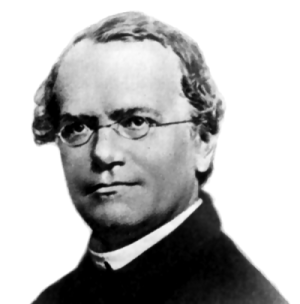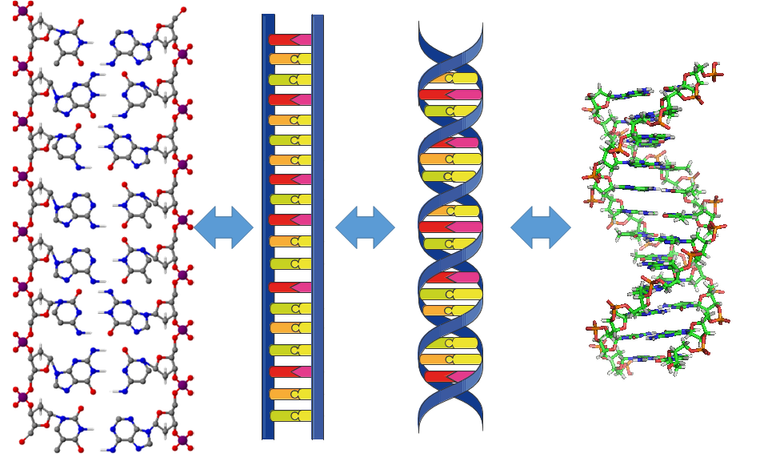Hello friends, this is my first publication in the science of biology and as I want to start big, I will start today with a very important topic, INHERITANCE, One of the fundamental questions that should have been studied and, if possible answered, Throughout the history of biology was "the issue of inheritance." How is it that characters are inherited from parents to children? What is the inheritance? How is it transmitted? What are the "transport units" of the inheritance?
This topic of study that I publish is divided into three parts. In this, the first, I will talk a little about the history of the beginnings of genetics and what are the basic concepts that you have to learn to move on to the other two sections. In the second part I will talk about what Mendel's laws are and how you can apply them to solve problems. In the third and last section, we go a little further and we explain what are the "allelic interactions" and how you can solve problems of this type. I invite you to observe this article so interesting!
The beginnings
From the beginning of history, the theories of inheritance had two conceptual aspects: one related to those interested in "improvement", especially of plants, and the second, related to the work of "hybridologists", those interested in the principles of inheritance in relation to the nature of the "species".
Hybridologists observed that when crossing two organisms, the result was not a different species. The "breeders", on the other hand, carried out experiments not to understand the nature of the species but to "improve" them. They were interested in some specific characteristics and not because of the overall appearance.
It is necessary to emphasize that at that time it was not known about the existence of chromosomes or the role and mechanism of meiosis. It was Mendel who could determine the existence of discrete "inheritance units" and predict their behavior during the formation of the gametes. Too bad nobody listened while he was alive.
Contributions from Mendel
Johann Mendel (Figure 1) was born into a peasant family in 1822, however he received a good education. He was admitted as a novice in the Augustinian monastery in the Moravian town of Brünn (Brno, present-day Czech Republic) under the adopted name of "Gregor". He studied the career as a teacher at the University of Vienna for two years. There he learned about the hybridization experiments carried out by Kölreuter and Gärtner, two recognized hybridologists. A nervous illness prevented him from completing his exams in Vienna, so he returned to Brno as substitute teacher at the local school. During the following years, Mendel made his classic experiments of hybridization using peas or also called peas or pea (Pisum sativum) that grew in the garden of the Monastery.
Mendel is an anomalous hero of science since his discoveries were ignored during his own life. A brilliant scientist who failed to make his contemporaries understand the meaning of what he was doing. Although Mendel published his results in 1865, they were not appreciated until the beginning of the 20th century, long after his death (1884). Despite this fact, their contributions are today the basis of genetics.
DNA: the "molecule of inheritance"
The DNA or deoxyribonucleic acid (Figure 2) contains the genetic information in the form of nucleotide sequences. In most cases, DNA segments ranging from a few hundred to many thousands of nucleotides are the genes that encode the information needed to synthesize a specific protein. This molecule was unknown by Mendel and even by those who rediscovered their laws at the beginning of the century. DNA was identified as a molecule of inheritance only in the 50's thanks to the experiments of Alfred Hershey and Martha Chase. And its double helix structure a few years later, by James Watson, Francis Crick and Rosalind Franklin.
As we tell you in the subject of cell division study i, the chromosomes are made up of DNA and proteins. Genes, therefore, are parts of chromosomes. So ... what does the transmission of genes have to do with meiosis? As the chromosomes are transmitted from one cell to another and from one organism to another during reproduction. Each gamete (produced by meiosis) contains genetic information of the parents. Thus, inheritance occurs when genes are transmitted from a parent to their offspring.
Locus, loci, alleles, homozygous, heterozygous, phenotype, genotype ...
Let's see some concepts that you have to learn before anything else. The physical place that a gene occupies within a chromosome is called a locus or in the plural, loci. Each member of a pair of homologous chromosomes has the same genes that occupy the same loci.
Different nucleotide sequences in the same locus of two homologous chromosomes are called alleles.
Let's see an example; imagine that there is a gene that codes for the character (observable characteristic) "color of the flower" of a hypothetical diploid plant species (they have pairs of homologous chromosomes) and the flowers can be red or white. One allele could be "red" flower color and the other "white" flower color (Figure 3).

Figure 3 : Scheme that represents in A, a chromosome (not duplicated). The centromere and the physical section where a hypothetical gene called locus is housed. In B the same chromosome is shown, but duplicated. The sister chromatids are indicated. In C, a pair of homologous chromosomes with different alleles whose genes code for the color character of the flower of a hypothetical diploid plant is represented. There are two alleles, one that would code for white flowers and one that would code for red flowering plants.
If two homologous chromosomes of a diploid organism have the same allele in a locus of a specific gene, the organism is said to be homozygous (The homozygous term comes from Greek words meaning "the same pair"). While if two homologous chromosomes have different alleles at one locus, the organism is said to be heterozygous ("different pair") (Figure 4). Following the previous example on the flower color of the plants, a homozygous plant would have the two alleles equal and a heterozygous plant would have the two different alleles.

Figure 4: Scheme of all possible homologous chromosomes of the previous example. When the organism has both the same alleles it is called homozygous (above) and when it has different alleles it is called heterozygous (below).
Finally, you have to know that the combination of alleles that an organism has (homozygous or heterozygous) is its genotype, while the characteristics of the organism that can be; its external appearance, its behavior, its digestive enzymes, its blood type or any other observable or measurable characteristic constitute its phenotype. In the above example of plants, the phenotype is red flowers or white flowers.
In the next inheritance section II, we deepened Mendel's contributions and what were the laws that are the basis of Genetics today.
References
- https://medievalstudies.ceu.edu/concept-and-history-cultural-heritage
- https://en.wikipedia.org/wiki/Heritage
- http://www.open.edu/openlearn/history-the-arts/history/heritage/what-heritage/content-section-2.1
Bibliography consulted:
- Filosophy and history of biology Ana Barahona, Edna Suárez and Sergio Martinez. UNAM, 2001 First edition.
"The tradition of the hybrids in the eighteenth and nineteenth centuries. The cell theory and its influence on the birth of biology. Daniel Piñero Chap. 16, p367 and "The emergence of Mendelism". Peter J. Bowler Cap. 18, p379 - Biology "Life on Earth", 6th ed. T. Audesirk, G. Audesirk & B. Byers.
- Concepts of genetics. 8th edition. Pearson Prentice Hall.


@origalworks